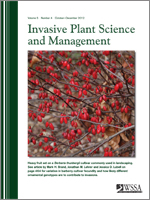Understanding the ecological characteristics of areas invaded and not invaded by exotic plants is a priority for invasive plant science and management. Buffelgrass is an invasive perennial species that managers view as a major threat to indigenous ecosystems of conservation lands in Australia, Mexico, the United States, and other locations where the species is not native. At 14 sites in Saguaro National Park in the Arizona Uplands of the Sonoran Desert, we compared the soil, vegetation, and soil seed bank of patches invaded and not invaded by buffelgrass. Abiotic variables, such as slope aspect and soil texture, did not differ between buffelgrass patches and patches without buffelgrass. In contrast, variables under primarily biotic control differed between patch types. Soil nutrients, such as organic C and NO3–N, were approximately twofold greater in buffelgrass compared with nonbuffelgrass patches. Average native species richness was identical (14 species 100 m−2) between patch types, but native plant cover was 43% lower in buffelgrass patches. Unexpectedly, native seed-bank densities did not differ significantly between patch types and were 40% greater than buffelgrass seed density below buffelgrass canopies. Results suggest that (1) soil nutrient status should not be unfavorable for native plant colonization at buffelgrass sites if buffelgrass is treated; (2) at least in the early stages of buffelgrass patch formation (studied patches were about 10 yr old), native vegetation species were not excluded, but rather, their cover was reduced; and (3) native soil seed banks were not reduced in buffelgrass patches.
Nomenclature: Buffelgrass, Pennisetum ciliare (L.) Link
Management Implications: Buffelgrass is a priority invasive, exotic species for managers of conservation lands in Australia, Mexico, and the United States because it can alter fire regimes and reduce native biodiversity. We compared ecological characteristics (soil, vegetation, and seed bank) of patches invaded and not invaded by buffelgrass at 14 sites in Saguaro National Park in the Arizona Upland Subdivision of the Sonoran Desert. Abiotic variables (e.g., aspect, soil texture) did not differ between patch types, whereas properties under biological control (e.g., soil organic C) differed between patch types. Soil nutrients, such as NO3–N and organic C, were about twice as concentrated in buffelgrass compared with patches without buffelgrass. Given that the nutrient-rich soils below native, perennial plants are key locations for native plant recruitment and nutrient concentrations below buffelgrass were similar to those below native perennials reported in the literature, results suggest that soil nutrient status in buffelgrass patches should not be unfavorable for native plant recruitment. Native plant species richness and diversity were identical on average between patch types, but native cover was less by about one-half in buffelgrass patches. Unexpectedly, native-soil seed banks were not reduced in buffelgrass patches.
Understanding cause–effect mechanisms of buffelgrass invasion, temporal changes in the characteristics of buffelgrass-invaded sites, and responses of these characteristics to buffelgrass treatment are important research needs. If buffelgrass invasion is the principal driver of the observed reduced cover of native plants in patches invaded by buffelgrass, treatment of buffelgrass in its early stages of invasion might be important, before the exclusion of native species. To summarize, compared with nonbuffelgrass patches, buffelgrass patches exhibited higher soil nutrients, identical native plant species richness and diversity, lower native plant cover, and similar native species soil seed bank densities.






